- Home
- »
- Medical Devices
- »
-
Transcutaneous Electrical Nerve Stimulation Market Report, 2030GVR Report cover
![Transcutaneous Electrical Nerve Stimulation Market Size, Share & Trends Report]()
Transcutaneous Electrical Nerve Stimulation Market Size, Share & Trends Analysis Report By Product (Portable, Table Top), By Application (2018 - 2030) (Chronic Pain, Acute Pain), By End-use, And Region Forecasts, 2024 - 2030
- Report ID: GVR-4-68039-920-2
- Number of Report Pages: 300
- Format: PDF, Horizon Databook
- Historical Range: 2018 - 2023
- Forecast Period: 2024 - 2030
- Industry: Healthcare
Market Size & Trends
The global transcutaneous electrical nerve stimulation market size was estimated at USD 321.11 million in 2023 and is expected to grow at a CAGR of 3.94% from 2024 to 2030. The demand for TENS devices is expected to increase owing to the rising prevalence of chronic pain and musculoskeletal injuries, especially among older citizens. TENS devices are primarily used to treat sports injuries, muscular atrophy, nerve pain, arthritis, labor pain, and back & neck pain. Chronic conditions such as arthritis, fibromyalgia, back pain, and neuropathic pain affect millions of people worldwide, leading to a high demand for effective pain management solutions. As per CDC data, in 2021, an estimated 20.9% of U.S. adults (51.6 million individuals) experienced chronic pain, and 6.9% (17.1 million individuals) experienced high-impact chronic pain. TENS therapy, which involves the use of low-voltage electrical currents to relieve pain, offers a noninvasive, drug-free alternative that appeals to patients seeking to avoid the adverse effects & potential dependency associated with long-term use of pain medications. This growing awareness and acceptance of TENS as a viable pain management option are propelling market expansion, as healthcare providers increasingly recommend TENS devices for their patients, and individuals seek out these devices for home use to manage their chronic pain effectively.
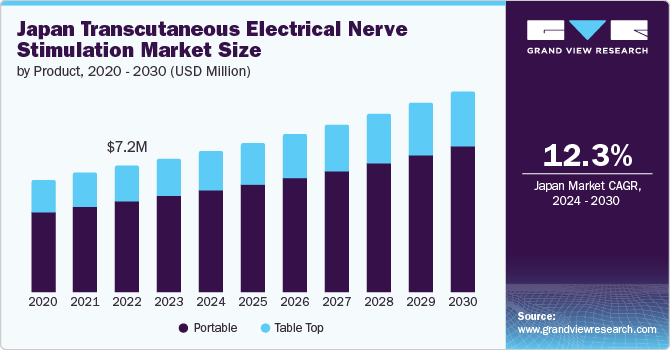
In addition, muscle injuries are becoming common among younger adults owing to increased involvement in sports and other physical activities. For instance, according to WHO data published in July 2022, around 1.71 billion people have musculoskeletal conditions worldwide. Therefore, a large number of sports enthusiasts are adopting muscle stimulation therapies, such as TENS, to assist in postinjury rehabilitation & warmup routines. All these factors are expected to augment the overall TENS market growth in the near future. Furthermore, the ineffectiveness of oral drugs is prompting patients to look for alternative treatment options, such as electrotherapy devices. People addicted to painkillers are more likely to suffer from severe adverse effects. In addition, overusing painkillers can make them ineffective. According to a study published in Practical Pain Management, only 14.0% of patients administered with codeine experienced reduced discomfort. In addition, scientists revealed that there was no single drug that provided pain relief to patients. The low preference for surgeries is another factor boosting the demand for TENS devices. Patients typically avoid surgery if alternative treatments, such as TENS, are available, supporting market growth over the forecast period.
Technological advancements in electrotherapy devices are anticipated to drive the market. Electrotherapeutics are evolving and incorporating new functions, including neuromodulation. Scientists, researchers, & healthcare providers are tapping into advanced circuitry and electrical signaling to modulate nerve function. Recent technological advancements include automatic, wearable, transcutaneous, and electrode-based electrical nerve stimulators. These devices provide pain relief within minutes. Furthermore, innovations in TENS technologies, such as the development of wireless and portable units, have made these devices more convenient & user-friendly. Features such as customizable settings, rechargeable batteries, and smartphone connectivity can enhance user experience & compliance. Advancements in TENS technology have led to devices with highly customizable settings, allowing users to tailor the intensity, frequency, and pattern of electrical pulses to their specific pain management needs. This personalization can help enhance the efficacy of treatments for different types of pain as per patient preferences.
Incorporating rechargeable batteries in TENS units has made these devices more sustainable and cost-effective. Users no longer need to frequently replace batteries, reducing the overall cost and environmental impact while ensuring the device is always ready for use. Continued miniaturization of electronic components has resulted in smaller, lighter, and more ergonomically designed TENS devices. These improvements make the devices more comfortable to wear and use discreetly under clothing. Such factors are expected to drive the adoption of TENS devices in clinical and home care settings, contributing to overall industry growth.
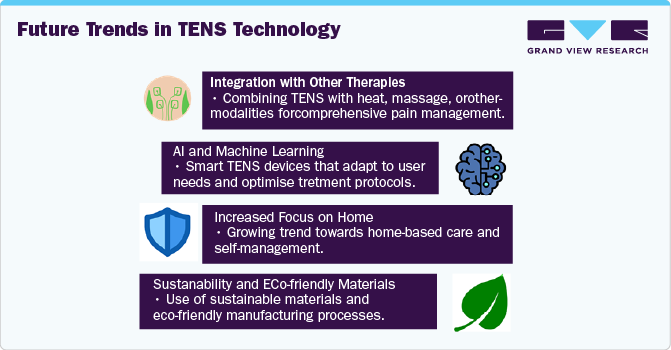
Clinical Trials
Clinical trials play a crucial role in the market. By helping validate the efficacy and safety of TENS devices for various medical conditions, these trials provide evidence-based data to support the use of TENS therapy in managing chronic pain, postoperative pain, & other conditions, such as fibromyalgia & osteoarthritis. By demonstrating positive outcomes in pain reduction and functional improvement, clinical trials can help gain regulatory approvals, boost clinician & patient confidence, and encourage wider adoption of TENS devices. Ongoing and future trials continue to explore new applications and refine treatment protocols, further expanding the potential market for TENS therapy.

NCT06324344, March 2024: This pilot project aims to investigate the feasibility and efficacy of a wireless TENS technique in treating Chemotherapy-induced Peripheral Neuropathy (CIPN).
NCT03868787, July 2023: This study assesses the effectiveness of TENS as a pain management technique during the implantation of an osmotic dilator before dilatation and evacuation.
Industry Dynamics
The industry growth stage is moderate, and its pace of growth is accelerating. The TENS market is characterized by a high degree of growth owing to rising cases of chronic vein disorders, growing number of orthopedic procedures, and increasing incidence of obesity.
Key strategies implemented by players in the TENS market include new product launches, approvals, expansion, acquisitions, and partnerships. For instance, in April 2023, Neuspera Medical announced that the U.S. FDA approved its next-generation ultra-miniaturized Neuspera system. The system consists of a micro-implant that uses a wireless platform with an iPad-based clinician programmer and wearable transmitter to deliver neurostimulation therapy.

Innovations include the development of wireless & portable devices, smartphone connectivity for personalized treatment plans, and enhanced safety features such as automatic shutoff. In addition, integration with other therapeutic modalities, such as heat & massage, and the incorporation of AI & ML for adaptive treatment protocols are transforming TENS therapy into a more effective and user-friendly pain management solution. This ongoing innovation is expanding the market and enhancing the overall efficacy & convenience of TENS devices.
In various regions worldwide, including North America, Europe, and Asia Pacific, TENS devices must undergo rigorous evaluations by regulatory bodies, such as the U.S. FDA, Europe’s EC, and China’s CFDA. These approvals validate the quality and performance of TENS devices and instill confidence among healthcare providers & patients. Therefore, device approvals are expected to drive the market by facilitating the entry of new players and boosting TENS therapy adoption as a trusted pain management solution.
Regulations significantly influence the TENS market, ensuring product safety, quality, and compliance with medical standards. Stringent regulatory requirements imposed by health authorities worldwide, such as the U.S. FDA and the CE mark in Europe, mandate rigorous testing & documentation for TENS devices prior to being marketed. These regulations ensure that TENS devices meet safety standards, provide effective pain management, and hold minimal risks. Compliance with regulatory requirements is essential for market entry & consumer trust, shaping the TENS market landscape and fostering innovation in design & manufacture.
Product expansion plans include the introduction of wireless & portable TENS units, smartphone-connected devices for personalized pain management, and devices with customizable settings for tailored treatment options. As companies continue innovating & expanding their product lines, patients benefit from more convenient, effective, and user-friendly options for managing chronic pain.
The TENS market comprises a wide range of products designed to meet the diverse needs of healthcare providers across various clinical settings. Ongoing technological advancements and innovations can further diversify product offerings & contribute to a competitive market landscape.
Regional expansion of players in the TENS market is driven by increasing demand for nonpharmacological pain management solutions across diverse geographic areas. As awareness about TENS therapy grows and regulatory environments become more favorable, manufacturers can expand their presence into new regions to capitalize on untapped opportunities. In addition, strategic partnerships, distribution agreements, & investments in local infrastructure facilitate market penetration and ensure accessibility to TENS devices for patients worldwide.
Product Insights
On the basis of product, the TENS market is segmented into portable and tabletop TENS units. In 2023, the portable TENS segment dominated the market due to the growing demand for at-home use devices and the increasing geriatric population, widening the pool of immobile patients. Portable TENS units are suitable because they are small and relatively distinct. Therefore, one can keep a TENS unit in their pocket or clip it onto a belt to ensure immediate pain relief at home or away. Thus, these factors are likely to contribute to segment growth over the forecast period.
The portable TENS segment is anticipated to grow at the fastest CAGR of 4.13% during the forecast period. Portable TENS are used extensively for preventing muscle atrophy, relaxation of muscle spasms, managing chronic pain due to arthritis, and increasing blood circulation. Moreover, key players in the market are offering various innovative stimulators under this segment. For instance, NeuroMetrix, Inc. offers a portable TENS pain relief kit that fits like a brace on patients and provides stimulation for pain relief. Zynex, Inc. offers JetStream, a portable system that can be used at home for treatment. OMRON Corporation offers a small-sized portable electrotherapy TENS device that can help relieve sore and aching muscles. These factors are anticipated to drive the global TENS market over the forecast period.
End-use Insights
On the basis of end-use, the market is segmented into hospitals, physiotherapy clinics, rehabilitation centers, home care, and others. The physiotherapy clinics segment held the largest share in 2023. The growing preference of physiotherapists for electrotherapies over manual techniques is expected to drive this segment. Moreover, increasing patient visits for stimulation therapies and the availability of these therapies at an affordable cost at physiotherapy clinics are anticipated to fuel the segment. In addition, medical reimbursement provided to patients seeking these therapies is anticipated to drive the segment over the forecast period.
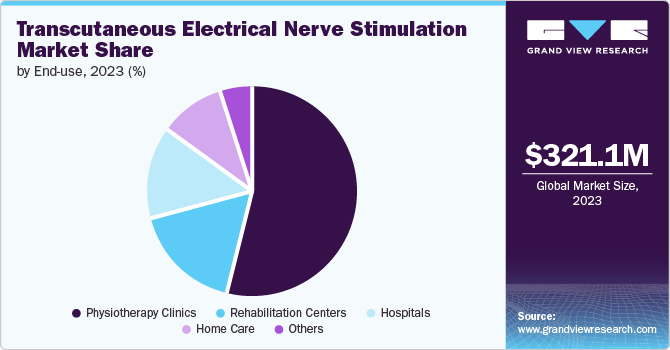
However, the homecare segment is expected to grow at the fastest CAGR of 5.03% during the forecast period. The patient-friendly, inexpensive, and safe nature of these devices is contributing to their growing popularity in at-home settings. In addition, rising hospital costs and chronic pain make home care a better option, especially for the elderly. For instance, as per WHO data published in October 2022, one in six individuals worldwide will be aged 60 years or older by 2030, with the overall demographic population increasing from 1 billion in 2020 to 1.4 billion by 2030. Individuals aged 60 years and above are expected to double (to 2.1 billion) worldwide by 2050. Between 2020 and 2050, there will be three times as many people aged 80 years or older, accounting for 426 million individuals. Since fall-related injuries in the elderly are a major health and social concern globally, this is expected to present a significant growth opportunity in the market over the forecast period. The advancements and availability of TENS units for at-home use have made it a preferred choice of pain relief therapy device. Its cost-effective nature makes it feasible for patients in developed and developing economies.
Application Insights
On the basis of application, the market is segmented into chronic pain and acute pain. The acute pain segment held the largest share in 2023. Acute pain is further subsegmented into sports injuries, postoperative pain, labor pain, and menstrual pain. Acute pain may be primarily caused by surgery, trauma, sports-related injuries, or other medical illnesses. As more people participate in sports and recreational activities, the risk of injuries increases. For instance, according to Stanford Medicine Children’s Health, in May 2024, over 3.5 million injuries were reported annually among children and teens (aged 14 years and younger) playing sports in the U.S. In addition, the rising number of surgical procedures and the increase in healthcare expenditure are likely to impel overall market growth. Opioids have been extensively used in the perioperative pain setting. However, the adverse effects associated with these medications have raised concern over alternative, device-based pain management therapies, including TENS. This is anticipated to contribute to market growth over the forecast period.
The chronic pain segment is expected to grow at the fastest CAGR of 4.16% during the forecast period. An increase in the incidence of chronic pain has prompted the industry to seek long-term solutions. For instance, as per WHO data published in June 2023, lower back pain affected 619 million people globally. In 2020, it was estimated that the number of cases will surge to 843 million by 2050. TENS are mainly used when chronic neck or back pain has not been relieved despite surgery or medications. With the increasing prevalence of chronic pain due to conditions such as failed back surgery, lumbar & cervical radiculitis, and neuropathy, the demand for TENS therapy is rising. This is anticipated to fuel the market over the forecast period.
Regional Insights
The North America transcutaneous electrical nerve stimulation market dominated the global market with the largest revenue share of 43.36% in 2023 and is likely to maintain its position over the forecast period. The presence of key participants, major investments by governments to develop innovative medical devices, and the early introduction of novel TENS devices are contributing to market growth in the region. Moreover, the high purchasing power of consumers and increased adoption of advanced technologies & innovative medical devices are further expected to drive the market. The presence of extensive public & private funding initiatives, especially in the U.S., has helped create awareness regarding advanced devices. Government initiatives, including the U.S. Affordable Care Act (ACA), focus on reducing the cost of medical devices. Acute pain is the region's most common cause of emergency room visits. According to data published by the National Institute of Health in November 2023, over 51 million U.S. individuals undergo inpatient surgery each year, and 80% experience acute surgical pain. This is expected to drive the region’s market over the forecast period.
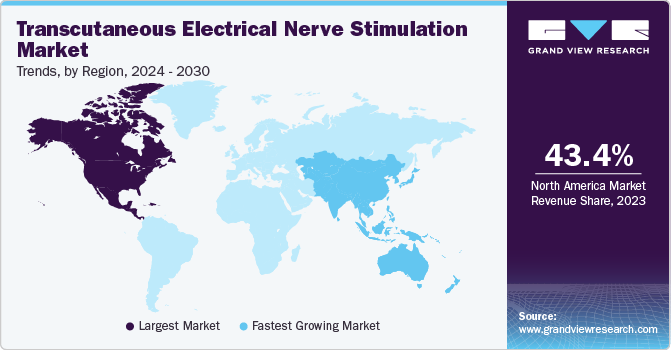
U.S. Transcutaneous Electrical Nerve Stimulation Market Trends
The transcutaneous electrical nerve stimulation market in the U.S. is expected to dominate North America’s market over the forecast period. The rising prevalence of chronic pain conditions such as arthritis and neuropathy is increasing the demand for effective pain management solutions. Technological advancements, including wireless and smartphone-connected TENS devices, can enhance user convenience & expand market reach. In addition, the shift toward nonpharmacological treatments due to the opioid crisis is boosting TENS device adoption. Favorable reimbursement policies and growing awareness about the benefits of TENS therapy among healthcare providers and patients further contribute to the market's expansion in the U.S.
Europe Transcutaneous Electrical Nerve Stimulation Market Trends
The transcutaneous electrical nerve stimulation market in Europe is expected to grow significantly over the forecast period. The increasing prevalence of chronic pain conditions, such as arthritis and neuropathic pain, is fueling the demand for effective pain management solutions. Technological advancements, including wireless connectivity, smartphone integration, and customizable settings, can help enhance user convenience & treatment efficacy. In addition, the rising focus on nonpharmacological therapies due to the opioid crisis and concerns over medication adverse effects is likely to propel market growth. Furthermore, favorable reimbursement policies and increasing awareness of TENS therapy among healthcare providers and patients can contribute to market growth in Europe.
The transcutaneous electrical nerve stimulation market in the UK is expected to grow moderately over the forecast period. The market is expected to be driven by rising awareness of nonpharmacological pain management, technological advancements in TENS devices, and an increasing prevalence of chronic pain conditions. In addition, favorable healthcare policies supporting noninvasive treatments are further propelling market expansion in the UK.
The France transcutaneous electrical nerve stimulation market is expected to grow over the forecast period. High demand for advanced home healthcare devices, widespread awareness & acceptance of TENS therapy among healthcare professionals, and government initiatives promoting alternative pain management methods to reduce reliance on opioids are likely to drive the market in France. In addition, the presence of a robust healthcare infrastructure can further propel the adoption of TENS devices in France.
The transcutaneous electrical nerve stimulation market in Germany is expected to witness steady growth over the forecast period. Key factors include an aging population, increasing prevalence of chronic pain conditions, and strong healthcare infrastructure. Moreover, a rise in home-based healthcare and high acceptance of nonpharmacological pain management solutions can further fuel market growth. In addition, robust health insurance coverage for TENS therapy and a strong emphasis on advanced medical technologies and innovations can fuel the market.
Asia Pacific Transcutaneous Electrical Nerve Stimulation Market Trends
The transcutaneous electrical nerve stimulation market in Asia Pacific is estimated to grow at the fastest CAGR of 5.32% over the forecast period. Growing awareness about maintaining health & fitness, increasing adoption of pain management therapies, and rising usage of smart devices for maintaining health are key growth drivers of this region’s market. Moreover, the increasing prevalence of sports injuries is expected to boost the demand for TENS units during the forecast period. Furthermore, the growing geriatric population in Asian countries with major untapped opportunities, such as Japan and China, is expected to drive market growth during the forecast period.
The transcutaneous electrical nerve stimulation market in China is expected to grow over the forecast period owing to the rising geriatric population and increasing prevalence of chronic pain conditions. According to WHO, an estimated 402 million people (28% of the population) will be aged over 60 years by 2040. In addition, advancements in healthcare infrastructure and the rising healthcare expenditure can improve accessibility to TENS devices among the Chinese population.
The India transcutaneous electrical nerve stimulation market is likely to experience significant growth. Key growth factors include the increasing prevalence of chronic pain conditions, such as arthritis & back pain, rising awareness & acceptance of noninvasive pain management therapies, and growing adoption of TENS devices in clinical & homecare settings. In addition, technological advancements, such as wireless connectivity and smartphone integration, are making TENS devices more convenient & user-friendly, further fueling market expansion in India.
The transcutaneous electrical nerve stimulation market in Japan is expected to grow over the forecast period. The country's aging population, coupled with a high prevalence of chronic pain conditions, creates a substantial demand for effective pain management solutions such as TENS. In addition, the growing awareness and acceptance of noninvasive & drug-free pain relief methods can contribute to the market expansion.
Middle East And Africa Transcutaneous Electrical Nerve Stimulation Market Trends
The transcutaneous electrical nerve stimulation market in the Middle East and Africa is expected to witness significant growth in coming years due to increasing investments in healthcare infrastructure and rising prevalence of chronic diseases & injuries. Advancements in healthcare infrastructure are expected to accelerate the development & adoption of medical devices in this region. Growing health insurance penetration, increasing privatization, and rising chronic pain burden are factors expected to drive regional market growth.
The transcutaneous electrical nerve stimulation market in Saudi Arabia is expected to grow over the forecast period. The Saudi Arabian government has been investing significantly in healthcare infrastructure to improve healthcare delivery and access. This includes the construction of new hospitals, medical centers, and specialized healthcare facilities, which can create opportunities to adopt TENS devices, enhancing clinical workflow & patient care.
The Kuwait transcutaneous electrical nerve stimulation market is expected to grow over the forecast period due to the escalating prevalence of chronic pain conditions and rising healthcare expenditure.
Key Transcutaneous Electrical Nerve Stimulation Company Insights
Major competitors, such as DJO Global, Omron Healthcare, and Zynex Medical, dominate the market with their extensive product portfolios & established distribution networks. These companies focus on innovation, product differentiation, & strategic partnerships to maintain their competitive edge and meet the diverse needs of healthcare providers & patients seeking effective pain management solutions. In addition, emerging players are entering the market with niche offerings, intensifying competition and driving further innovation in the market. Mergers, acquisitions, partnerships, and distribution network strengthening are key strategies market players adopt to fuel their growth & meet expansion goals.
Key Transcutaneous Electrical Nerve Stimulation Companies:
The following are the leading companies in the transcutaneous electrical nerve stimulation market. These companies collectively hold the largest market share and dictate industry trends.
- OMRON Corporation
- Zynex Medical
- NeuroMetrix, Inc.
- EMS Physio Ltd.
- BioMedical Life Systems
- DJO Global, Inc.
- Globus
- Beacmed s.r.l.
- Iskra Medical d.o.o.
- Ito Co., Ltd.
Recent Developments
-
In October 2023, NeuroMetrix and the National Fibromyalgia Association collaborated to enhance the quality of life for people suffering from fibromyalgia. NeuroMetrix would sponsor and help the NFA’s mission to offer education, support, & advocacy for fibromyalgia patients.
-
In April 2021, DJO (Colfax Corporation) completed the acquisition of MedShape, Inc., a leading provider of medical devices for fracture fixation, joint fusion, and soft tissue injury repair.
-
In September 2020, NeuroMetrix, Inc. launched the Quell App for Apple Watch users. It is a wearable TENS device for knee, foot, & leg pain, available over the counter.
Transcutaneous Electrical Nerve Stimulation Market Report Scope
Report Attribute
Details
Market size value in 2024
USD 332.66 million
Revenue forecast in 2030
USD 419.48 million
Growth rate
CAGR of 3.94% from 2024 to 2030
Actual data
2018 - 2023
Forecast period
2024 - 2030
Quantitative units
Revenue in USD million and CAGR from 2024 to 2030
Report coverage
Revenue forecast, company ranking, competitive landscape, growth factors, and trends
Segments covered
Product, application outlook, end-use outlook, region
Regional scope
North America; Europe; Asia Pacific; Latin America; Middle East & Africa (MEA)
Country scope
U.S.; Canada; Mexico; UK; Germany; Italy; France; Spain; Denmark; Sweden; Norway; Japan; China; India; South Korea; Australia; Thailand; Brazil; Argentina; South Africa; Saudi Arabia; UAE; Kuwait
Key companies profiled
OMRON Corporation; Zynex Medical; NeuroMetrix, Inc.; EMS Physio Ltd.; BioMedical Life Systems; DJO Global, Inc.; Globus; Beacmed s.r.l.; Iskra Medical d.o.o.; Ito Co., Ltd.
Customization scope
Free report customization (equivalent up to 8 analysts working days) with purchase. Addition or alteration to country or regional & segment scope.
Pricing and purchase options
Avail customized purchase options to meet your exact research needs. Explore purchase options
Global Transcutaneous Electrical Nerve Stimulation Report Segmentation
This report forecasts revenue growth at the global, regional, and country levels and provides an analysis on the latest industry trends in each of the sub-segments from 2018 to 2030. For this study, Grand View Research has segmented the transcutaneous electrical nerve stimulation market report based on product, application, end-use, and region:
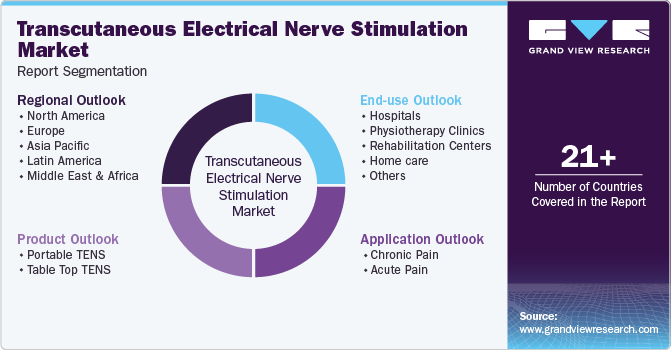
-
Product Outlook (Revenue, USD Million, 2018 - 2030)
-
Portable TENS
-
Table Top TENS
-
-
Application Outlook (Revenue, USD Million, 2018 - 2030)
-
Chronic Pain
-
Arthritis
-
Back & Neck Pain
-
Fibromyalgia
-
Neuropathic Pain
-
Others
-
-
Acute Pain
-
Sports Injuries
-
Postoperative Pain
-
Labor Pain
- Menstrual Pain
-
-
-
End-use Outlook (Revenue, USD Million, 2018 - 2030)
-
Hospitals
-
Physiotherapy Clinics
-
Rehabilitation Centers
-
Home care
-
Others
-
-
Regional Outlook (Revenue, USD Million, 2018 - 2030)
-
North America
-
U.S.
-
Canada
-
-
Europe
-
UK
-
Germany
-
France
-
Italy
-
Spain
-
Denmark
-
Sweden
-
Norway
-
-
Asia Pacific
-
Japan
-
China
-
India
-
South Korea
-
Australia
-
-
Latin America
-
Brazil
-
Mexico
-
Argentina
-
-
Middle East & Africa
-
South Africa
-
Saudi Arabia
-
UAE
-
Kuwait
-
-
Frequently Asked Questions About This Report
b. The global transcutaneous electrical nerve stimulation market size was estimated at USD 321.11 million in 2023 and is expected to reach USD 332.66 million in 2024.
b. The global transcutaneous electrical nerve stimulation market is expected to grow at a compound annual growth rate of 3.94% from 2024 to 2030 to reach USD 419.48 million by 2030.
b. North America dominated the TENS market with a share of 43.36% in 2023. This is attributable to the rising cases of chronic & acute pain, the presence of key participants, and huge investments by governments in the development of innovative medical devices in the region.
b. Some of the key players operating in the transcutaneous electrical nerve stimulation market include OMRON Corporation, Zynex Medical, NeuroMetrix, Inc., EMS Physio Ltd., BioMedical Life Systems, DJO Global, Inc., Globus, Beacmed s.r.l., Iskra Medical d.o.o., Ito Co., Ltd., and other players.
b. Key factors that are driving the transcutaneous electrical nerve stimulation market growth include the rising cases of chronic pain and musculoskeletal injuries, especially among older citizens as well as the ineffectiveness of oral drugs prompting patients to look for alternative treatment options.
Share this report with your colleague or friend.
![gvr icn]()
NEED A CUSTOM REPORT?
We can customize every report - free of charge - including purchasing stand-alone sections or country-level reports, as well as offer affordable discounts for start-ups & universities. Contact us now
![Certified Icon]()
We are GDPR and CCPA compliant! Your transaction & personal information is safe and secure. For more details, please read our privacy policy.
We are committed towards customer satisfaction, and quality service.
"The quality of research they have done for us has been excellent."





